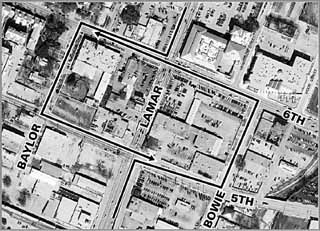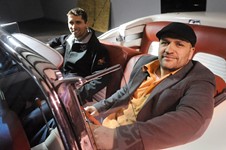Downtown Mobility? Take Your Turns
Transportation Department proposes new downtown mobility plan
By Jordan Smith, Fri., April 19, 2002

If the city's Transportation, Planning and Sustainability Dept. staff has its way, downtown Austin may look very different in the years to come -- that is, should downtown stakeholders and the City Council agree with recommendations the department is currently floating around town. The suggestions come after two years of computer-aided study by the department, and include recommendations that would change many central business district streets from one-way to two-way and begin incorporating elements of the Great Streets Master Plan -- including more and wider sidewalks. "We're focusing on making downtown more pedestrian- and more retail-friendly," said Department Director Austan Librach.
And so far -- at least from downtown -- the response has been positive. (The council isn't expected to receive the recommendations until June.) "It strikes a really good balance between the need to be able to get in and out of downtown, and making it a better place when you're here," said Lucy Buck, associate director of the Downtown Austin Alliance. The DAA's Board of Directors on April 16 voted to support the city staff recommendations. "They've done a really good job of working through a pile of studies."
The recommendations call for Second, Brazos, Colorado, Ninth, 10th, Seventh, Eighth, Trinity, and San Jacinto -- in roughly that order -- to be converted from one- to two-way streets. The plan also calls for Third Street to become one-way westbound, paired with one-way eastbound Cesar Chavez; a reversible lane on the Drake Bridge (South First) to handle "peak hour" traffic concerns; and left-turn restrictions during peak hours on Congress from Second to 10th, and from Lamar Boulevard onto Fifth and Sixth -- among other things. If approved, the $10 million in traffic changes would be implemented over the next three years; the $68 million in Great Streets improvements -- including widening downtown sidewalks to 32 feet in some areas -- would be completed within the next two to three years.
Librach said that the changes will not impact traffic on the major corridors -- Fifth, Sixth, Guadalupe, and Lavaca -- but will provide for pedestrian- and development-friendly access on the other, less heavily trafficked (now) one-way corridors, such as San Jacinto and Colorado. "We really expect most traffic to remain on [the major corridors]," Librach said, "but it's changed for pedestrian-friendliness." Indeed, according to Buck, retail developers have told the Alliance that two-way streets are essential to attracting more business to the downtown area. "Those are calmer areas," she said, "and more user-friendly."
However, the conversion of some downtown streets, paired with proposed left-turn restrictions, are expected to actually cause new delays in traffic -- from an additional 14 seconds for trips on Brazos and Colorado, to 93 seconds for trips on Seventh and Eighth Streets. Moreover, while the less-populated streets may become more user-friendly, the study doesn't appear to do much to alleviate any traffic concerns on what would remain the city's major traffic corridors.
Under the new proposals, during "peak hours" (broadly defined as morning, noon, and evening rush hours) at the intersections of Lamar Boulevard with Fifth and Sixth, drivers heading either north or south on Lamar would not be able to turn east onto Fifth or west onto Sixth, respectively. Instead, if you wish to head west on Sixth from northbound Lamar, you would be required to turn east onto Fifth, then north on Bowie (which dead-ends at Sixth Street opposite GSD&M), and only then hang a left (west) onto Sixth. Similarly, southbound Lamar drivers hoping to head east on Fifth would have to go west on Sixth to Baylor and turn left, traveling south one more block, before finally turning east onto Fifth.
The computer models apparently do not take into account the existing congestion in the Lamar/Sixth area -- exacerbated in the last few years by the city's eagerness to promote development around that intersection, seemingly before any traffic consequences were fully considered. But Librach said that the computer models, along with outside consultants, suggest that by adding additional "through time" at those intersections -- achieved by forbidding the left-turns -- more cars will move more efficiently directly through those intersections. "That will take the left-turn movements out of the signal progression," he said. "That will help the traffic move through the intersection sooner than would otherwise be possible." The Lamar no-left-turn plan -- the first of the new traffic proposals to be implemented if the council approves the recommendations -- would first go through a six-month trial period. If there are any problems, Librach said, they can be ironed out.
Despite some of those potential problems, such as a short-term increase in delayed traffic and its associated air pollution, the recommendations have garnered support from the Austin Sierra Club. "The Sierra Club likes to see anything that raises bicycle and pedestrian activity," said chair Karin Ascot. In the long run, she said -- if the proposals are, indeed, fully implemented -- air pollution would be lowered as more pedestrians, cyclists, and mass-transit riders replace cars. "Over time there would be more non-auto activity, and that's a really good thing." Ascot said she believes the city can improve on the current recommendations by exploring the addition of dedicated bus lanes, coupled with more cohesive bike lanes. "You have two options when you're talking about mobility," she said. "You can make things better for cars or you can make things better for pedestrians, but you can't do both at once."
Got something to say on the subject? Send a letter to the editor.








